Measuring Internet performance
Written by Daniel "DanTheMan" ErikssonMeasure bandwidth
The procedure below will measure your performance against a major Internet traffic interchange in Stockholm/Sweden (D-GIX). This is mainly useful for people that play online games on servers located on one of the major networks in Sweden. In the case of F1 Racing league, our server is located on the network owned by Telia (biggest ISP in Sweden). Telia also owns Skanova, the biggest supplier of raw bandwidth in Sweden, who has as its customers most of the major providers.
Getting TPTEST
TPTEST is an application developed under contract from the government (I believe) that provides Swedish broadband customers an easy way to measure their performance against the claims of their providers. Unfortunately the program is only available in Swedish, but it is very easy to use (just a click or two) and the output is language neutral anyway.
You can download TPTEST from the official homepage (http://tptest.iis.se/), or you can download it directly from this server (tp305swe.exe, 124kB).
Using TPTEST
TPTEST will measure your bandwidth (both upstream and downstream) against one of many test-servers located at or close to the national traffic interchange in Stockholm (D-GIX). It is pretty safe to assume that the bandwidth you have available to this location is what you will have available to the F1 Racing league server also. There are currently no bottlenecks between D-GIX and the location of the F1 Racing league server (6 hops and ~6ms round trip delay).
When you start the application you are presented with a very simple interface:
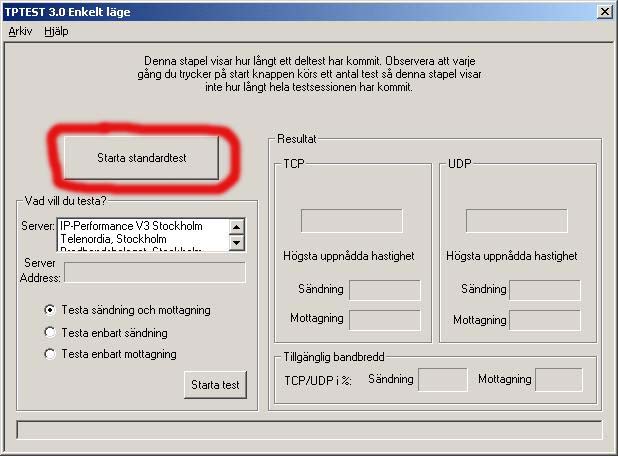
The big button labeled "Starta standardtest" will start a basic test against the primary test server. The test only takes
a few minutes and will measure both upstream and downstream performance for TCP and UDP traffic. In F1 Challenge, most of
the traffic is in the form of UDP packets being passed back and forth (some TCP is also used, but it is only a tiny fraction
of the total traffic). Once the test has finished you will be presented with the results in the lower right corner of the
dialog:
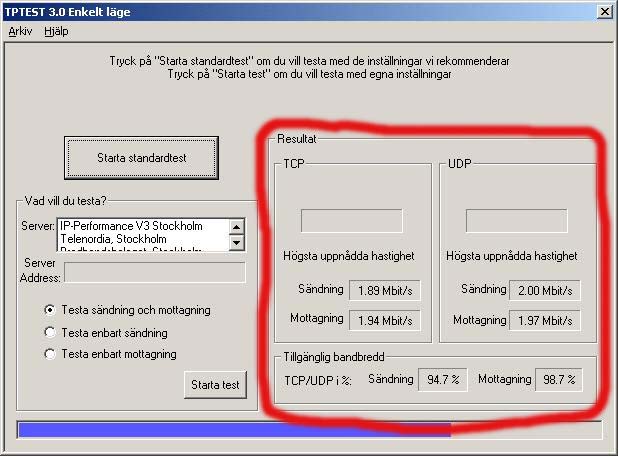
"Sändning" means transmission, and shows your upstream bandwidth. "Mottagning" means reception, and shows the downstream bandwith. "Högsta uppnådda hastighet" means highest achieved speed, and "Tillgänglig bandbredd" means available bandwidth.
The above measurement is done against a computer not operated by my ISP, but it often gives (slightly) better results than
the test-server provided by Telia. If you want you can run the same test against my provider. To do this you need to select
"Telia, Stockholm" from the list, and press the "Starta test" button:
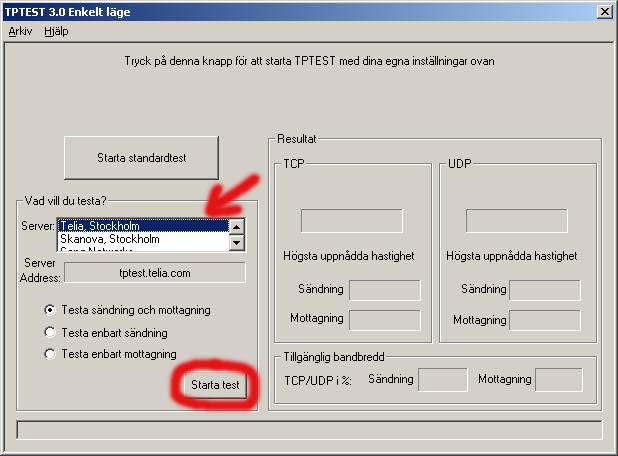
The difference between this server and the previous server should be very small (if any at all). If you see a large difference I would really like to hear from you. It could be an indication of bad routing tables at your ISP, or bad traffic exchange arrangements between your ISP and my ISP.
Measure latency
In networking the term latency is often used to describe the time it takes for a packet to travel from your computer to another computer, and for the response packet to travel back to you. Another expression often used is "round trip delay". In online games the latency is often referred to as "ping-time", because the utility used for measuring the latency is called ping. Ping uses a protocol called ICMP (other example of protocols is UDP and TCP, all three of them lives on top of IP which is the underlying transport layer).Using ping
All version of Windows include the ping utility, so there is no need to download anything. The only thing you need to do
is to start a command promt and run the ping utility against a suitable server. In the case of F1 Racing league, the best
server to test against would be the actual computer that I use to host games on. However, if you run a test while I am
downloading or uploading something your results will be affected. Instead I suggest you run the test against a gateway
computer located on the same subnet as my server. The difference is only one single hop of less than 1ms, so you will get
a very accurate results using this server. The address of the gateway computer is 213.64.66.253. Run the test like this:
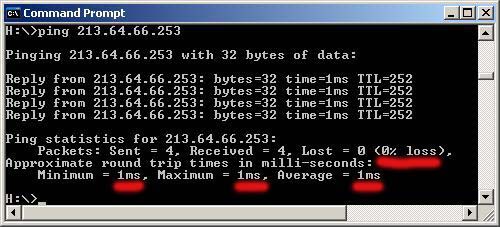
The marked numbers show the amount of packet loss (packet loss is VERY bad, and even small amounts will wreck havoc when
racing online), and the min/max/avg round trip delay (latency). By default the ping utility under Windows will send out
4 ping-requests and then expit. To get a better sample you can instruct it to send ot more ping-requests by using the
"-n" option. Here's an exmaple on how to get it to make 25 ping-requests:
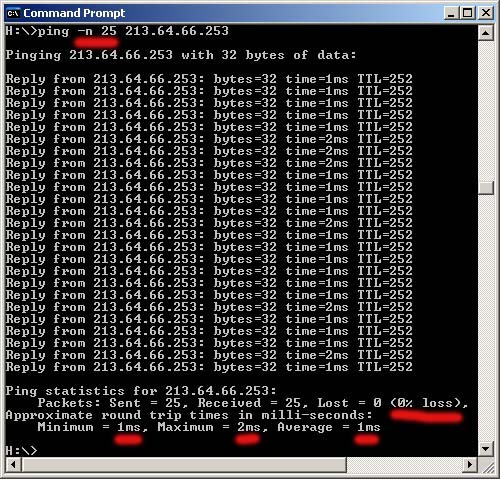
If you have studied the above screenshots you might have noticed that ping by default uses 32 byte packets to make the
measurements. In most cases this is a suitable packet size because what you really are trying to measure is the latency
of a connection when small packets are used. When playing F1 Challenge the average packet is probably around 150 bytes
instead of 32, so to get a value that is closer to the actual latency of the connection when used for playing F1C you
can instruct ping to use 150 byte packets instead of the default. You do this with the "-l", like this:
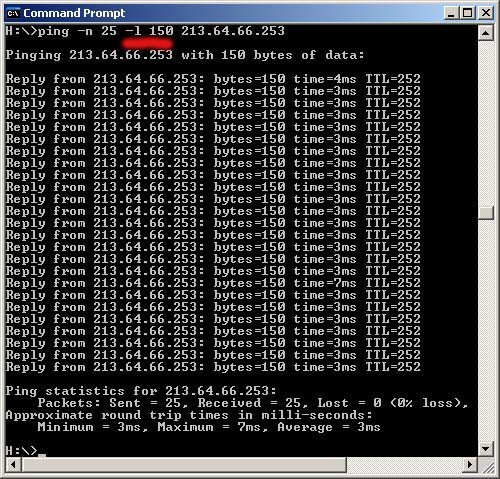
As you can see the average latency shoots up when using larger packets. This is to be expected!
Proper testing
The best way to test your bandwidth or latency is to run the same test several times at around the same time of day as when you would normally be playing or racing online games. If you only take one measurement you might get a bad result because of temporary traffic congestion or other more serious problems. If the results vary a lot between consecutive tests you might have a heavily congested link somewhere between your location and my server. One way to diagnose this is to use the "pathping" utility (shipped win WinXP, don't know if other systems also has it). Pathping works a bit like a combination of traceroute and ping, and from the output it is possible to see the latency added by each hop. Pathping takes a while to execute (up to 20 minutes if there are many hops between you and the server you are pinging), and the results can be a bit intimidating to anyone not intimately familiar with networking lingo.